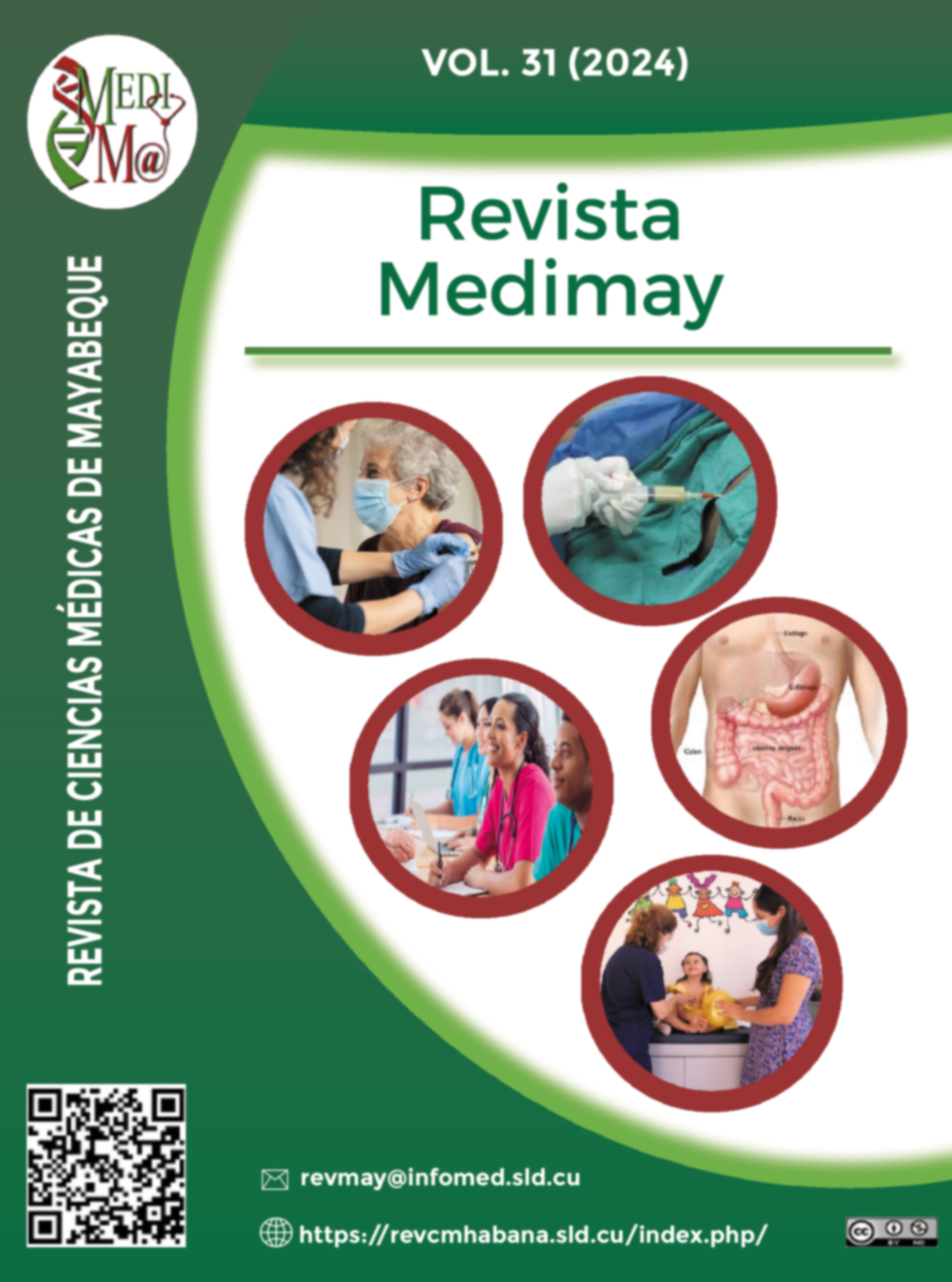Cervical pessary as a method of primary prevention of prematurity
Keywords:
premature birth, pregnancy, cervical patency, cervicometry, cervical pessaryAbstract
Introduction:
Preterm birth is complex and multifactorial. Cervicometry is based on the premise that there is a relationship between cervical length and the onset of labor.
Objective:
Describing the use of the cervical pessary as a method of preventing prematurity.
Methods:
A descriptive observational study was carried out in a series of cases, municipality of Güira de Melena, province of Artemisa, Cuba, from January 2019 to September 2022. Cervical pessary were place to a sample of 42 pregnant women with single pregnancies and risk cervicometry. The variables analyzed were: gestational age at insertion of the pessary, functional cervical length; patency of the internal cervical orifice and gestational age at the delivery. The statistical program SPSS version 21® for Windows was used for the data. Descriptive statistics were used, with measurements of absolute frequencies, percentages, central tendency and minimum-maximum.
Results:
The gestational age that predominated when placing the pessary was less than 28 weeks with 69%, the average gestational age was 23.4 weeks with a minimum of 22 and a maximum of 32. 73.8 %. of pregnant women, had a functional cervical length between 20.1 mm and 25 mm. 83.3% of patients had a patency of less than five mm. 76 % of pregnant women gave birth after 37 weeks and only 7.1% gave birth between 28 and 33.6 weeks.
Conclusions:
The cervical pessary is used as a method of primary prevention of preterm birth, with a short neck.
Downloads
References
Nicolaides KH, Syngelaki A, Poon LC, Picciarelli G, Tul N, Zamprakou A, et al. A randomized trial of a cervical pessary to prevent preterm singleton birth. N Engl J Med. [Internet]. 2016[citado 28 Ene 2023];374(11):1044-52. Disponible en: https://doi.org/10.1056/NEJMoa1511014
Romero R, Conde-Agudelo A, Da Fonseca E, O’Brien JM, Cetingoz E, Creasy GW, et al. Vaginal progesterone for preventing preterm birth and adverse perinatal outcomes in singleton gestations with a short cervix: a meta-analysis of individual patient data. Am J Obstet Gynecol [Internet]. 2018; [citado 28 Ene 2023]; 218(2):80. Disponible en: https://www.sciencedirect.com/science/article/abs/pii/S0002937817323438
Zemet R, Schiff E, Manovitch Z, Cahan T, Yoeli-Ullman R, Brandt B, et al. Quantitative assessment of physical activity in pregnant women with sonographic short cervix and the risk for preterm delivery: A prospective pilot study. PLoS One [Internet]. 2018[citado 28 Ene 2023];13(6):e0198949. Disponible en: https://pubmed.ncbi.nlm.nih.gov/29889906/
Arabin B, Alfirevic Z. Cervical pessaries for prevention of spontaneous preterm birth: Past, present and future. Ultrasound Obstet Gynecol [Internet]. 2013; [citado 28 Ene 2023];42(4):390–9. Disponible en:
https://www.ncbi.nlm.nih.gov/pmc/articles/PMC4282542/pdf/uog0042-0390.pdf
Pacagnella R, Mol B, Borovac-Pinheiro A. A randomized controlled trial on the use of pessary plus progesterone to prevent preterm birth in women with short cervical length (P5 trial). BMC Pregnancy Childbirth [Internet]. 2019 [citado 28 Ene 2023]; 19(1):1-9. Disponible en: https://bmcpregnancychildbirth.biomedcentral.com/track/pdf/10.1186/s12884-019-2513-2.pdf
Daskalakis G, Maria Goya , Pergialiotis V , Luis Cabero, Kyvernitakis L, Antsaklis A et al. Prevention of spontaneous preterm birth. Arch Gynecol Obstet [Internet]. 2019[citado 28 Ene 2023];299:1261–73. Disponible en: https://pubmed.ncbi.nlm.nih.gov/30761417/
Rigol Ricardo O, Santisteban Alba SR. Obstetricia y Ginecología. [Internet]. 4tªed. La Habana: Ciencias Médicas; 2023. Disponible en: http://www.bvscuba.sld.cu/libro/obstetricia·y·ginecología·cuarta·edición/
Huertas Tacchino Erasmo. Parto pretérmino: causas y medidas de prevención. Rev peru Ginecol Obstet. [Internet]. 2018 Jul [citado 2023 Ene 28]; 64(3):399-404. Disponible en: http://www.scielo.org.pe/scielo.php?script=sci_arttext&pid=S230451322018000300013&lng=es. http://dx.doi.org/https://doi.org/10.31403/rpgo.v64i2104.
Ferrero S, Cobo T, Murillo C, Palacio M. Protocolo: Manejo de la paciente con riesgo de parto pretérmino. Protoc Med Fetal I Perinat Hosp Clinic- Hosp St Joan D u- Univ Barcelona [Internet]. 2019 [citado 28 Ene 2023];(3). Disponible en: http://medicinafetalbarcelona.org/protocolos/es/patologia-materna obstetrica/manejo-de-la-paciente-con-riesgo-de-parto-prematuro.html
Capobianco G, Saderi L, Aliberti S, Mondoni M, Piana A, Dessole F, et al. COVID 19 in pregnant women: A systematic review and meta-analysis. Eur J Obstet Gynecol Reprod Biol. 2020 [citado 11 Jul 2021];252:543-58. Disponible en: https://www.ncbi.nlm.nih.gov/pmc/articles/PMC7363619/
Cambero Martínez Y. Temas de obstetricia para la atención primaria de salud. La Habana: Ciencias Médicas; 2019. 253 p. Disponible en: http://www.ecimed.sld.cu/
Amanda. J. Uso de pesario cervical y prevención de parto pretérmino. Revista de la Facultad de Ciencias Médicas [Internet]. 2020 [citado 28 Ene 2023];45(1). Disponible en: https://doi.org/10.29166/rfcmq.v45i1.3399
Serrano-Diana C, Amezcua-Recover AN, Gil-Martínez Acacio L, Roque-Fernández MA, González-Mirasol E. Parto a través de rotura uterina posterior en una paciente con pesario de Arabin. Ginecol Obstet Mex. [Internet]. 2019 Mar [citado 28 Ene 2023]; 87(3):208-12. Disponible en: https://doi.org/10.24245/gom. v87i3.2652
Guzmán Parrado. R, Nodarse Rodríguez. A, Guerra Chang. E, Sanabria Arias AM, Couret Cabrera MP, Díaz Garrido D. Caracterización del uso de pesario cerclaje como prevención del parto pretérmino. Rev Cubana Obstet Ginecol [Internet]. 2013 Jun [citado 28 Ene 2023];39(2):87-97. Disponible en:
http://scielo.sld.cu/scielo.php?script=sci_arttext&pid=S0138600X2013000200004&lng=es.
Dugoff L, Berghella V, Sehdev H, Mackeen AD, Goetzl L, Ludmir J. Prevention of preterm birth with pessary in singletons (PoPPS): randomized controlled trial. Ultrasound Obstet Gynecol [Internet]. 2018 [citado 28 Ene 2023];51(5):573-79. Disponible en: https://obgyn.onlinelibrary.wiley.com/doi/epdf/10.1002/uog.18908
Boelig RC, Schoen CN, Frey H, Gimovsky AC, Springel E, Backley S, et al. Vaginal progesterone vs intramuscular 17-hydroxyprogesterone caproate for prevention of recurrent preterm birth: a randomized controlled trial. American Journal of Obstetrics & Gynecology [Internet]. 2022 [citado 28 Ene 2023];226(5):[aprox. 2 p.]. Disponible en: https://doi.org/10.1016/j.ajog.2022.02.012
.
Reyna-Villasmil E, Mejía-Montilla J, Reyna-Villasmil N, Torres-Cepeda D, Rondón-Tapia M, Briceño-Pérez C. Índice de consistencia cervical o longitud cervical en la predicción de parto pretérmino inminente en pacientes sintomáticas. Revista chilena de obstetricia y ginecología [Internet]. 2021[citado 28 Ene 2023];86:274-81. Disponible en: http://www.scielo.cl/scielo.php?script=sci_arttext&pid=S071775262021000300274&nrm=iso
.
Coloma M, Gallardo Arozena M, Goya M, Nandwani C, Álvarez de la Rosa M. Evolución y costes de la prematuridad por indicación médica en un hospital de tercer nivel. Revista chilena de obstetricia y ginecología [Internet]. 2021 [citado 28 Ene 2023];86:3-13. Disponible en: https://www.scielo.cl/pdf/rchog/v86n1/0717-7526-rchog-86-01-0003.pdf
Abdel-Aleem H., Shaaban OM., Abdel-Aleem MA, Aboelfadle-Mohamed A. Cervical pessary for preventing preterm birth in single-ton pregnancies. The Cochrane database of systematic reviews [Internet]. 2022 [citado 28 Ene 2023];12(12);CD014508. Disponible en: https://doi.org/10.1002/14651858.CD014508
Published
How to Cite
Issue
Section
License
Copyright (c) 2024 Luis Gustavo García Baños, Marilín Alonso Sicilia, Olga Lidia Baños Carmona

This work is licensed under a Creative Commons Attribution-NonCommercial 4.0 International License.
Medimay protects copyright from the very first moment the submission is made, but upon publication it assumes a Creative Commons 4.0 (cc-by-nc) license, which allows the use of the work to share (copy and redistribute the material in any medium or format) and adapt (remix, transform and build from the material) as long as exclusive mention is made of the publication in the journal as a primary source, prohibiting its commercialization. The author always retains his/her right.















 This site is licensed under a
This site is licensed under a